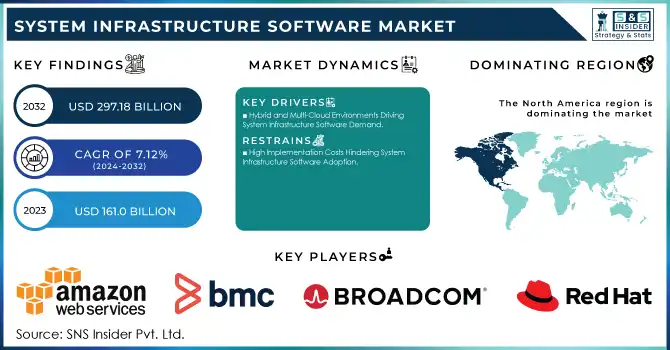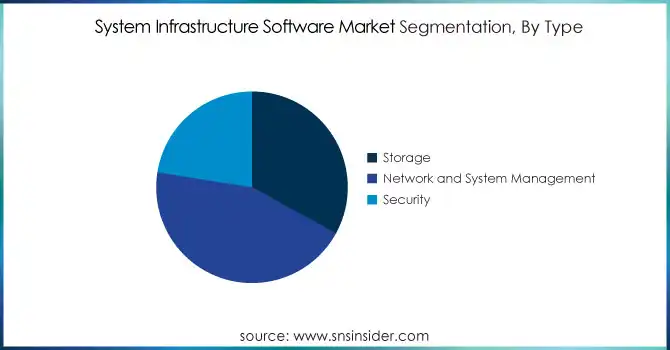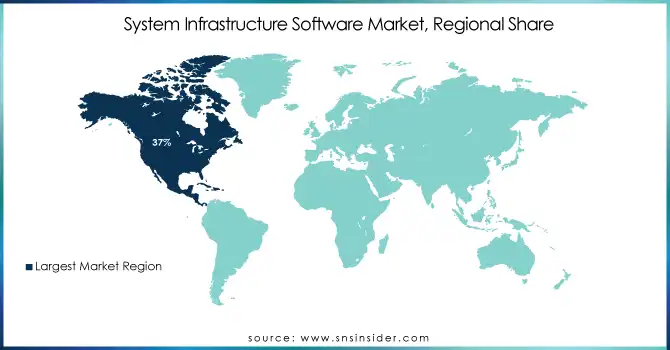System Infrastructure Software Market Report Scope & Overview:
The System Infrastructure Software Market was valued at USD 161 billion in 2023 and is expected to reach USD 297.18 billion by 2032, growing at a CAGR of 7.12% from 2024-2032.
The system infrastructure software market is experiencing robust growth as businesses increasingly rely on advanced IT solutions to enhance their operational efficiency. This growth is largely fueled by the widespread adoption of cloud computing, with 87% of organizations reporting business acceleration from their use of cloud technologies. Innovations such as virtualization and edge computing are also reshaping how companies manage and scale their IT infrastructures. A notable example is the 2025 collaboration between Black Sesame Technologies and iSoft, integrating iSoft’s AUTOSAR systems with Black Sesame’s C1200 chips to advance intelligent driving solutions. As organizations embrace these cutting-edge technologies, the demand for sophisticated infrastructure management software continues to rise, enabling businesses to optimize performance, improve scalability, and reduce costs while staying competitive in a rapidly evolving digital landscape.

Get More Information on System Infrastructure Software Market - Request Sample Report
The acceleration of digital transformation efforts across industries is further driving this demand, with 90% of businesses actively engaged in digital initiatives, showcasing a widespread priority. Notably, 66% of enterprise organizations and 49% of small businesses have adopted a digital transformation strategy. As businesses strive to stay competitive, they require software solutions that not only streamline their infrastructure but also enable seamless integration, enhance network performance, and automate key processes. To improve customer experience, 57% of enterprises plan to adopt automation methods, reflecting the growing emphasis on efficiency and innovation. This increasing reliance on automation aligns with the rising complexity of IT environments, solidifying the role of system infrastructure software in ensuring smooth, secure, and reliable operations in today’s digital-first landscape.
Looking to the future, the system infrastructure software market is poised for continued expansion, with AI, machine learning, and IoT technologies presenting new opportunities for innovation. In 2024, IBM Power highlighted plans to modernize infrastructure and enhance AI-driven innovation with the launch of the IBM Power11 processor and Spyre Accelerator. These advancements are driving the need for more intelligent, data-driven infrastructure management solutions that support real-time data processing and autonomous decision-making. As a result, demand for software that enables seamless integration across multi-cloud and hybrid environments will intensify, paving the way for long-term market growth.
System Infrastructure Software Market Dynamics
Drivers
-
Hybrid and Multi-Cloud Environments Driving System Infrastructure Software Demand
The growing adoption of hybrid and multi-cloud environments is fueled by the need for greater flexibility, scalability, and cost-efficiency. In fact, 89% of companies now use a multi-cloud approach, with 94% of all companies worldwide incorporating cloud computing into their operations. Organizations are increasingly utilizing a mix of on-premises, private, and public cloud solutions to address diverse operational needs while ensuring business continuity. However, this multi-cloud approach brings challenges in terms of integration, management, and security across various platforms. To navigate these complexities, there is an increasing demand for advanced infrastructure software that facilitates seamless interoperability, centralized management, and resource optimization across different cloud environments. As businesses seek agility and avoid vendor lock-in, the necessity for robust, scalable infrastructure software solutions that can support hybrid and multi-cloud strategies continues to grow.
-
Automation and AI Advancements Fueling System Infrastructure Software Demand
The rise of artificial intelligence and automation technologies has created a demand for advanced system infrastructure software to manage increasingly complex IT environments. As businesses adopt AI-driven solutions, they require infrastructure that can efficiently handle the scale, processing power, and data requirements of these technologies. Automation, in particular, is driving the need for infrastructure software capable of streamlining operations, reducing human error, and improving overall efficiency. Real-time analytics, enabled by AI, necessitate infrastructure that can support high-speed data processing, storage, and retrieval. The integration of AI and automation into everyday business processes also calls for scalable, reliable software that ensures smooth system performance while maintaining security. As these technologies continue to evolve, the demand for sophisticated infrastructure software grows to support them effectively.
Restraints
-
High Implementation Costs Hindering System Infrastructure Software Adoption
The initial investment required for deploying advanced infrastructure software can be substantial, especially for small and medium-sized enterprises. The costs associated with purchasing software licenses, hardware, and hiring specialized personnel for implementation and training can be a significant barrier for organizations operating on limited budgets. For cost-sensitive industries, this financial burden may delay or prevent the adoption of essential infrastructure solutions. Additionally, ongoing maintenance and upgrade expenses can add to the overall cost, making businesses hesitant to invest in new technologies. In response, Microsoft's USD 30 billion infrastructure fund is promoting the vertical integration of AI, enhancing its AI capabilities and providing greater control over its infrastructure. This strategic move improves operational efficiency and reduces costs, potentially alleviating financial pressures and fostering the broader adoption of advanced infrastructure solutions across industries, including among smaller players.
-
Concerns Over Vendor Lock-in Impacting System Infrastructure Software Adoption
Many businesses are wary of becoming reliant on a single vendor for their infrastructure needs, as this dependency can limit flexibility and drive up long-term costs. The fear of vendor lock-in arises from the difficulty of switching providers once a particular software solution has been fully integrated into existing systems. This can create challenges in terms of cost, time, and effort required to migrate to a new platform. As a result, businesses may hesitate to adopt new software solutions, fearing that they could be locked into unfavorable contracts or pricing structures. This reluctance can slow down the adoption of innovative infrastructure software, as companies seek more open, interoperable solutions that offer greater control and flexibility over their technology stacks.
System Infrastructure Software Market Segmentation Analysis
By Type
The Network and System Management segment dominated the System Infrastructure Software market with the highest revenue share of approximately 45% in 2023 due to the increasing complexity of IT infrastructures across industries. As businesses continue to expand their digital operations, the need for robust network and system management solutions grows. These tools provide organizations with the ability to streamline operations, optimize resource utilization, and ensure system reliability, which are critical for maintaining a competitive edge in an increasingly interconnected world.
The Security segment is expected to grow at the fastest CAGR of around 9.06% from 2024 to 2032, driven by rising cybersecurity threats and stringent regulatory requirements. As organizations handle larger volumes of sensitive data, the demand for advanced security solutions to protect against breaches, malware, and other cyber threats intensifies. With businesses increasingly prioritizing data protection, the need for specialized security infrastructure is becoming paramount, making it a key area of focus for innovation and investment in the coming years.

By Application
The Data Center Infrastructure segment led the System Infrastructure Software market in 2023 with the highest revenue share of approximately 39%, driven by the rapid growth of data center operations globally. As businesses increasingly shift toward digital transformation, there is a rising demand for efficient data storage, management, and processing solutions. Data centers serve as the backbone of these operations, requiring advanced infrastructure software to manage complex systems, ensure scalability, and maintain high availability, making it the dominant segment in the market.
The Cloud Integrations segment is poised to grow at the fastest CAGR of about 8.87% from 2024 to 2032, as businesses increasingly adopt multi-cloud strategies. The need for seamless integration of diverse cloud platforms is becoming critical for organizations aiming to optimize workflows and enhance flexibility. Cloud integrations enable businesses to connect various cloud services, facilitating smooth data exchange, scalability, and real-time collaboration, driving rapid growth in this segment as organizations seek more efficient and cost-effective cloud-based solutions.
By End User
The IT & Telecom segment dominated the System Infrastructure Software market with the highest revenue share of approximately 23% in 2023, primarily due to the expanding demand for advanced infrastructure in telecommunications and IT services. With the ongoing deployment of 5G networks and the increasing need for high-speed data communication, telecom companies rely heavily on robust infrastructure software to manage complex networks, ensure service reliability, and support rapid technological advancements, solidifying the sector’s dominance in the market.
The BFSI segment is expected to grow at the fastest CAGR of about 9.74% from 2024 to 2032, driven by the sector’s increasing reliance on digital transformation and the need for enhanced security. As financial institutions continue to adopt innovative technologies such as blockchain, AI, and cloud computing, they require advanced infrastructure software to ensure seamless operations, compliance, and data protection. The growing emphasis on secure, real-time financial transactions and digital customer experiences is fueling rapid growth in the BFSI segment.
System Infrastructure Software Market Regional Outlook
North America led the System Infrastructure Software market in 2023 with the highest revenue share of approximately 37%, primarily due to the region’s strong technological infrastructure and high demand for digital transformation across industries. The presence of key market players, coupled with rapid advancements in cloud computing, AI, and 5G networks, has positioned North America as a leader in infrastructure software adoption. Additionally, robust investment in data centers and IT services has further fueled market growth in the region, cementing its dominance.
Meanwhile, Asia Pacific is expected to grow at the fastest CAGR of about 9.38% from 2024 to 2032, driven by the rapid digitalization of emerging economies and increasing infrastructure investments. Countries like China, India, and Japan are undergoing significant technological advancements, with a surge in demand for cloud computing, IoT, and 5G. This is propelling the need for advanced system infrastructure software to support scaling operations, improve efficiency, and ensure cybersecurity, making the region a key growth driver in the coming years.

Do You Need any Customization Research on System Infrastructure Software Market - Enquire Now
Key Players
-
Amazon Web Services, Inc. (Amazon EC2, Amazon S3)
-
BMC Software, Inc. (BMC Helix ITSM, BMC TrueSight)
-
Broadcom Inc. (CA Technologies) (CA Unified Infrastructure Management, CA Automic Automation)
-
Red Hat, Inc. (Red Hat Enterprise Linux, OpenShift)
-
Hewlett Packard Enterprise (HPE) (HPE OneView, HPE Nimble Storage)
-
Nutanix (Nutanix Acropolis, Nutanix Prism)
-
SolarWinds (SolarWinds Network Performance Monitor, SolarWinds Server & Application Monitor)
-
Cisco Systems, Inc. (Cisco Intersight, Cisco UCS Manager)
-
Dell Inc. (Dell EMC OpenManage, VMware vSphere)
-
IBM Corporation (IBM Tivoli, IBM Cloud Pak for Automation)
-
Microsoft Corporation (Windows Server, Microsoft Azure)
-
Oracle Corporation (Oracle VM, Oracle Solaris)
-
TIBCO Software Inc. (TIBCO Spotfire, TIBCO Enterprise Message Service)
-
CA Technologies (CA Service Management, CA API Management)
-
Microsoft Corporation (Windows Server, Microsoft Azure)
-
Symantec Corporation (Symantec Endpoint Protection, Symantec Data Loss Prevention)
-
Dell Inc. (Dell EMC OpenManage, VMware vSphere)
-
Red Hat Inc. (Red Hat Enterprise Linux, OpenShift)
-
EMC Corporation (EMC Isilon, EMC VMAX)
-
Hewlett Packard Co. (HP OneView, HP Insight Control)
-
BMC Software Inc. (BMC Helix ITSM, BMC TrueSight)
-
IBM Corporation (IBM Tivoli, IBM Cloud Pak for Automation)
-
Apple Inc. (macOS Server, Xcode)
Recent Developments
-
In 2024, AWS and NVIDIA expanded their collaboration to enhance generative AI by integrating NVIDIA's Blackwell GPUs into AWS, boosting AI infrastructure for large-scale models. This partnership aims to optimize performance and deliver next-gen computing power for AI applications.
-
At VMware Explore 2024 in Barcelona, Broadcom introduced VMware Tanzu Data Services and VeloRAIN to enhance AI workloads and IT modernization. The company also unveiled VMware Cloud Foundation upgrades and new security features, such as AI-powered threat detection, to support cloud transformation and strengthen resilience.
-
In November 2024, Red Hat launched Red Hat Enterprise Linux 9.5, expanding Linux automation and adding enhanced security features. This version aims to simplify IT management and support AI workloads, providing improved security, automation, and hybrid cloud support.
| Report Attributes | Details |
|---|---|
| Market Size in 2023 | USD 161 Billion |
| Market Size by 2032 | USD 297.18 Billion |
| CAGR | CAGR of 7.12% From 2024 to 2032 |
| Base Year | 2023 |
| Forecast Period | 2024-2032 |
| Historical Data | 2020-2022 |
| Report Scope & Coverage | Market Size, Segments Analysis, Competitive Landscape, Regional Analysis, DROC & SWOT Analysis, Forecast Outlook |
| Key Segments | • By Type (Storage, Network and System Management, Security) • By Application (Building Management, Integrated Communications, Data Center Infrastructure, Cloud Integrations) • By End User (IT & Telecom, BFSI, Retail, Healthcare, Manufacturing, Transportation & Logistics, Others) |
| Regional Analysis/Coverage | North America (US, Canada, Mexico), Europe (Eastern Europe [Poland, Romania, Hungary, Turkey, Rest of Eastern Europe] Western Europe] Germany, France, UK, Italy, Spain, Netherlands, Switzerland, Austria, Rest of Western Europe]), Asia Pacific (China, India, Japan, South Korea, Vietnam, Singapore, Australia, Rest of Asia Pacific), Middle East & Africa (Middle East [UAE, Egypt, Saudi Arabia, Qatar, Rest of Middle East], Africa [Nigeria, South Africa, Rest of Africa], Latin America (Brazil, Argentina, Colombia, Rest of Latin America) |
| Company Profiles | Amazon Web Services, Inc., BMC Software, Inc., Broadcom Inc. (CA Technologies), Red Hat, Inc., Hewlett Packard Enterprise (HPE), Nutanix, SolarWinds, Cisco Systems, Inc., Dell Inc., IBM Corporation, Microsoft Corporation, Oracle Corporation, TIBCO Software Inc., Symantec Corporation, EMC Corporation, Hewlett Packard Co., Apple Inc. |
| Key Drivers | • Hybrid and Multi-Cloud Environments Driving System Infrastructure Software Demand • Hybrid and Multi-Cloud Environments Driving System Infrastructure Software Demand |
| Restraints | • High Implementation Costs Hindering System Infrastructure Software Adoption • Concerns Over Vendor Lock-in Impacting System Infrastructure Software Adoption |

